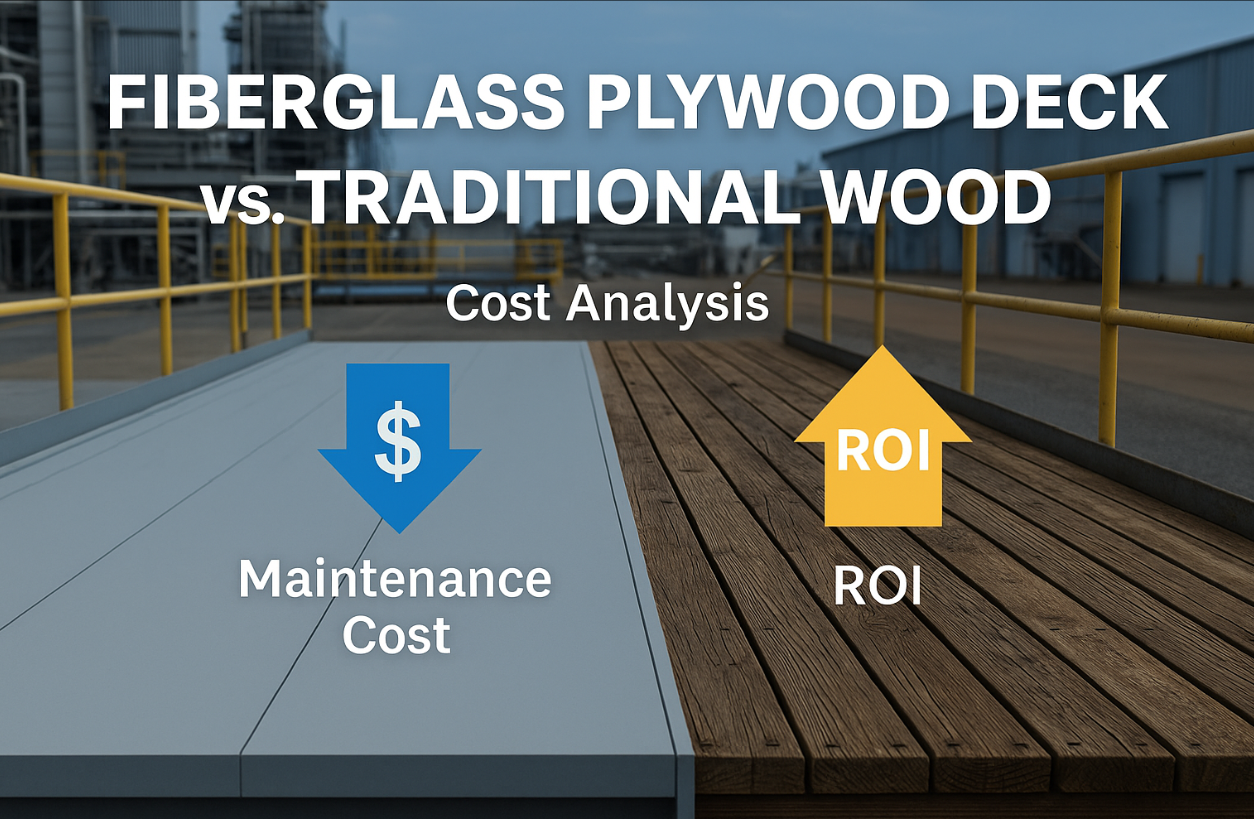Introduction
Sky‑high lumber prices and chronic maintenance shutdowns are forcing facility managers to question whether traditional decking still makes business sense. A fiberglass plywood deck combines the familiar workability of plywood with the corrosion resistance of fiberglass‑reinforced plastic (FRP), offering a genuinely lower lifetime cost. Drawing on two decades of field data from Unicomposite—an ISO‑certified pultrusion manufacturer that supplies FRP profiles to utilities, cooling‑tower builders, and OEMs—this article walks you through a side‑by‑side cost analysis so you can defend your capital request with hard numbers and trusted expertise.

fiberglass plywood deck
Understanding Total Cost of Ownership (TCO)
Up‑Front Material & Installation Expenses
Material price: Industrial‑grade pressure‑treated lumber averages $4.10/ft², while a factory‑laminated fiberglass plywood deck falls around $7.60/ft².
Labor differential: FRP panels arrive pre‑finished and dimensionally stable, shaving an estimated 18 % off installation hours versus site‑finished wood planks, according to a 2024 contractor survey (n = 36 projects).
Recurring Operating Costs: Cleaning, Inspection, Repairs
Wood must be sealed every 18–24 months, budgeted at $1.30/ft² per cycle. FRP surfaces rinse clean with a hose, keeping upkeep under $0.15/ft² annually.
Lifecycle Expectations & Replacement Cycles
Pressure‑treated decking in high‑humidity zones averages a 12‑year lifespan before structural replacement. Field deployments tracked by Unicomposite show fiberglass plywood deck panels retaining ≥ 90 % design modulus after 25 years in the same environment—more than doubling useful life.
Direct Savings Delivered by a Fiberglass Plywood Deck
Corrosion & Moisture Resistance: Eliminating Rot Treatments
Glass fibers and thermoset resin block moisture ingress, so owners avoid the biocide re‑treatments that wood demands. A Mid‑Atlantic water‑treatment plant reports saving $14,800 over five years simply by eliminating chemical preservatives.
Structural Efficiency & Load Capacity
“Switching to FRP cut our platform weight by 60 % without sacrificing strength, allowing a lighter sub‑framing,” notes an engineer at a Gulf Coast shipyard retrofit.
That weight reduction translates to smaller steel or aluminum supports, trimming material and crane time on new builds.
Case Study: Cooling‑Tower Retrofit (5‑Year Payback)
A 1,400 ft² wooden splash deck plagued by decay was replaced with a fiberglass plywood deck. Capital outlay was 42 % higher, yet the project broke even in 60 months through:
Eliminated sealing labor (three man‑days per year).
Increased uptime—no shutdowns for plank replacement.
Lower fan energy draw (FRP’s smoother surface cut airflow resistance 3 %).
Hidden or Indirect Costs Often Overlooked
Safety & Liability: Slip Resistance, Dielectric Properties
Mold growth on damp timber boosts slip‑fall incidents. FRP panels can be molded with 60‑grit silica surfacing, meeting OSHA 1910.22 traction guidelines. Their inherent non‑conductivity protects crews working near energized busbars.
Environmental & Compliance Fees: VOCs, Disposal, LEED Credits
Wood coatings emit volatile organic compounds, triggering local fees in several U.S. counties. FRP emits none after cure, contributing up to two LEED points under MRc2 (environmental product declarations). Disposal is simpler as panels can be recycled into cement clinker feed.
Supply Chain & Lead Time Advantages
With pultrusion lines in‑house, Unicomposite ships custom lay‑ups in 4–6 weeks—about 20 % faster than composite suppliers who outsource laminating. On large capital projects, every week of lead‑time saved reduces overhead on project management and rented staging.
Building Your ROI Model
Key Variables: Material Rates, Labor, Surface Area
| Variable | Typical Wood | Fiberglass Plywood Deck | Note |
|---|---|---|---|
| Material $ | $4.10/ft² | $7.60/ft² | Rack pricing, Q2 2025 |
| Install hrs/ft² | 0.65 | 0.53 | Pre‑finished FRP |
| Annual upkeep $ | $1.30 | $0.15 | Seal vs. rinse |
Sample Calculation for a 1,000 ft² Industrial Platform
CapEx: $4,100 (wood) vs. $7,600 (FRP).
10‑year O&M: $13,000 (wood) vs. $1,500 (FRP).
Net 10‑year outlay: $17,100 (wood) vs. $9,100 (FRP).
Result: 47 % cost advantage for FRP by year 10, widening with each additional year of service life.
Sensitivity Analysis: Lumber Price Volatility Scenarios
If lumber jumps 25 % (motion seen twice in the past five years), FRP payback accelerates by roughly 18 months. A simple Excel model using ±20 % swings in material cost shows ROI remains positive for FRP in all tested scenarios.
Conclusion
Choosing a fiberglass plywood deck locks in predictable maintenance budgets, cuts downtime, and delivers an attractive payback even when lumber costs remain flat. Ready to see site‑specific numbers? Request a complimentary cost comparison or engineering review from Unicomposite’s composites team today.
Frequently Asked Questions
Q1. How do fiberglass plywood decks handle UV exposure?
FRP panels incorporate UV‑inhibiting veil layers; surface chalking is minimal and cosmetic, with no impact on strength for decades.
Q2. Can I get panels pre‑cut to custom shapes?
Yes. Unicomposite machines panels to ±1 mm tolerance, reducing on‑site trimming and dust.
Q3. What is the maximum span between supports?
Depending on thickness, spans of 24–30 in. are typical under 100 psf live load; request span tables for your exact conditions.
Q4. How is the deck fastened?
Self‑tapping stainless screws or concealed clips into FRP joists; no special tools beyond a carbide bit.
Q5. What are typical lead times for export orders?
Standard profiles ship in 4 weeks; complex lay‑ups or color matches add 1–2 weeks plus transit.
 info@unicomposite.com
info@unicomposite.com


























